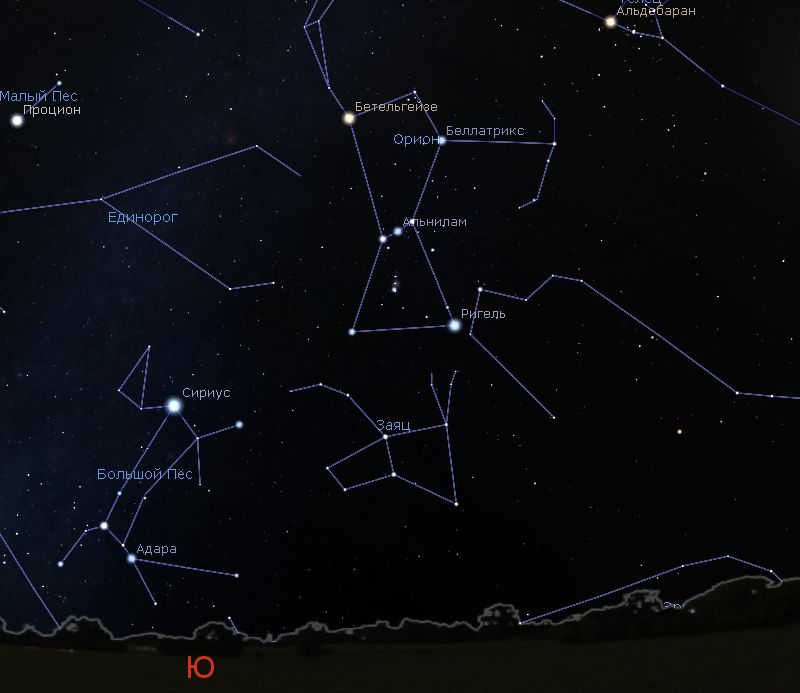Not many are aware, but it was the Big Dog constellation that introduced the term “vacation” into our vocabulary. The reason being that Sirius, the most brilliant star in this constellation and in the entire northern hemisphere, becomes visible in the early morning just before the summer solstice. In ancient Egypt, this occurrence signified the onset of the Nile flooding and the arrival of summer heat, which brought about a halt in most work activities. Additionally, Sirius was commonly referred to as the Dog Star, derived from the Latin word “canis”. Hence, this period of downtime came to be known as the “dog days” or vacations.
By the way, in ancient times, these summer holidays were not enjoyable, but rather feared. It was not without reason that Sirius was known as the Dog Star, and summer was referred to as the Dog Days. During this period, various infections were particularly widespread, and Africa was always teeming with them. Therefore, the appearance of Sirius in the morning not only signaled a time for rest, but also the potential for succumbing to a fever. Thus, Sirius was a star that commanded both reverence and fear. Additionally, this star held great significance in numerous ancient religions.
Today, we are no longer frightened by the constellation Canis Major, so let us delve deeper into its mysteries.
Ways to Spot the Big Dog Constellation
Locating the Big Dog constellation is usually effortless as it is impossible to miss Sirius, the most prominent star in the heavens, with a magnitude of -1.4. Situated adjacent to the Orion constellation, it can be found below and to the left, causing it to rise later.

The Big Dog constellation can be observed later in the year, typically by the end of November or in December, when Orion is already high above the horizon. Unlike Orion, which can be seen in October and November, the Big Dog appears a little later. This makes it one of the winter constellations and the best time to study it.
Sirius, the brightest star in the night sky, is located almost in a straight line through the three stars of Orion’s belt, but slightly lower. It is easily identifiable and serves as a guide to finding the other stars in the Big Dog constellation.
Noteworthy Stars in the Big Dog Constellation
When discussing remarkable stars within the Big Dog constellation, there are numerous options that are worth observing.
Sirius
This particular star within the Big Dog constellation is not inherently extraordinary. Its significance lies in its proximity to Earth, as it is a mere 8.6 light years away. This close distance accounts for its remarkable brightness, despite being only twice the size and mass of our Sun. Sirius is classified as a hot white star and emits 22 times more light than our Sun. If our Sun were to swap positions with Sirius, the intense heat would cause all the seas and oceans on Earth to evaporate.
What’s fascinating is that Sirius is actually a binary star. Surprisingly, it was initially observed by Friedrich Bessel, a German astronomer and mathematician, in 1844, and he documented it on paper. He meticulously studied numerous observations of this star and detected its slight oscillation in space, occurring approximately once every 50 years. This phenomenon can only be accounted for by the existence of a sufficiently massive companion – a second star – in the system.
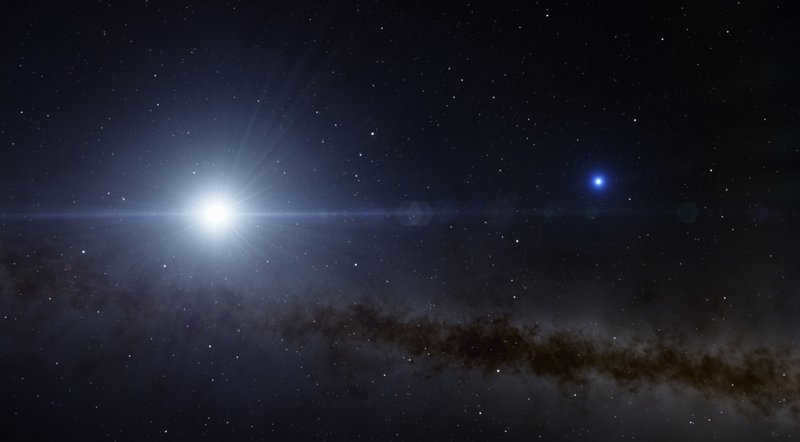
The Space Engine simulator features the Sirius system.
In 1844, Bessel proposed the existence of a second component in Sirius, and in 1862, Alvan Clarke, using his new 18-inch refractor, successfully observed and discovered Sirius B, also known as Puppy. This groundbreaking discovery further validated the theory of gravitation, as it transitioned from a theoretical concept to a tangible reality.
Puppy holds the distinction of being the first white dwarf ever discovered by humankind. Despite having a mass similar to that of the sun, its diameter is comparable to that of the Earth. Consequently, its matter is incredibly dense, to the extent that a matchbox-sized volume of Puppy would weigh over a ton. Essentially, Puppy is a star that solely emits light due to compression, making it a fascinating celestial phenomenon.
At one point, the Sirius system was composed of a pair of massive stars – one weighing twice as much as the Sun (Sirius A) and the other weighing five times as much as the Sun (Sirius B, or Puppy). However, the larger star, Puppy, rapidly burned through its fuel and transformed into a red giant. Eventually, it shed its outer layers and collapsed into a white dwarf.
Interestingly, historical records from the 1st and 2nd centuries AD mention this phenomenon. For instance, Claudius Ptolemy described Sirius as a bright red star. However, sources from the 10th century always depict Sirius as it appears today – a white star. These accounts may be accurate, as Puppy did indeed become a red giant that outshone its white companion. It has since dimmed significantly, now shining around 10,000 times fainter.
Currently, the binary nature of Sirius can be observed using a small telescope, although the dominant component’s brightness makes it challenging to observe the fainter one. Nevertheless, when the Lesser Dog star is deflected to its maximum separation of 11 arc seconds, it becomes easily detectable.
V*Y of the Canis Majoris
This star is truly remarkable, not only within the Canis Major constellation but also in the entire night sky. The reason being, it is one of the largest and most luminous stars presently known – a crimson hypergiant with a diameter ranging from 1300 to 1640 times that of the Sun, and by some calculations – 2100 times larger! In numerical terms, this equates to approximately 3-4 billion kilometers, or 17-19 astronomical units. Similar to numerous red giants, this star pulsates, causing variations in its diameter and brightness – ranging from 6.5 to 9.6m, making it visible through binoculars or a small telescope.
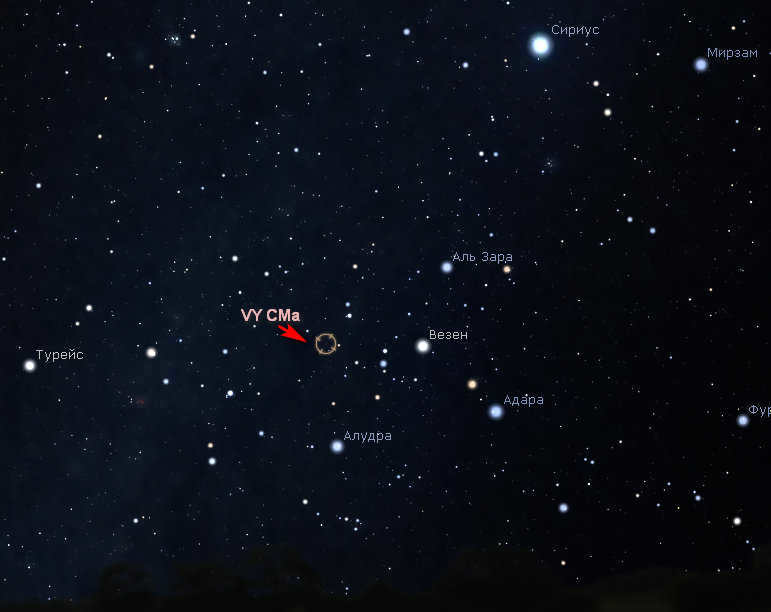
The whereabouts of the VY Big Dog can be found here.
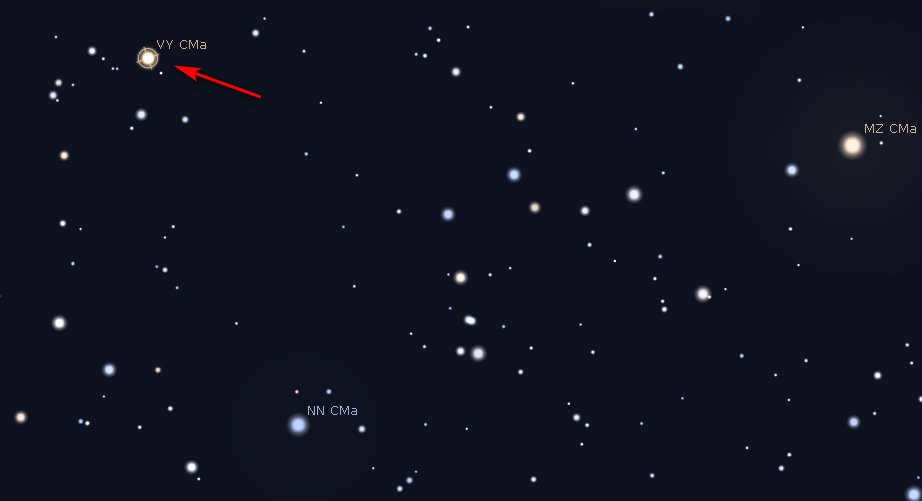

The region surrounding VY Big Dog in the Stellarium software.
In spite of its outward appearance as an ordinary star in the night sky, VY Big Dog possesses truly incredible dimensions. It would take light a staggering 8 hours to complete a full orbit around it (compared to a mere 14.5 seconds for the Sun), and a cutting-edge supersonic aircraft would have to fly nonstop for 220 years at a speed of 4500 km/h just to circumnavigate it! If this celestial body were to take the Sun’s place, its surface would extend beyond the orbit of Saturn.
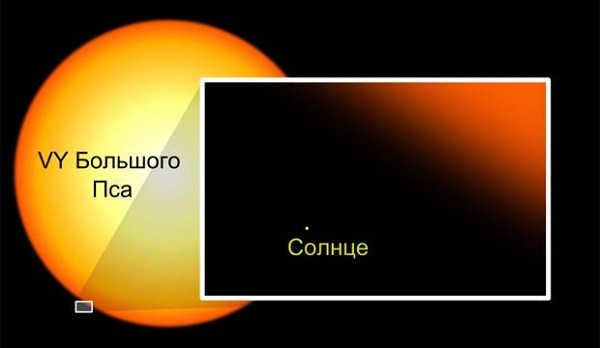
A comparison of the magnitude of the Sun and the VY Big Dog.
If you wish to observe this celestial body, bear in mind that despite its nondescript facade, it is merely a behemoth amidst a plethora of behemoths. Moreover, its unimposing demeanor is solely attributable to its location 3,900 light years distant. Any ordinary star positioned at such an astronomical measure would be imperceptible to the naked eye, even when employing an exceptionally potent telescope.
Star clusters in the Canis Major constellation
The Canis Major constellation contains numerous galaxies, clusters, binary stars, and other celestial objects. However, spotting many of them requires a telescope with a minimum aperture of 200 mm or greater. Hence, we will only discuss the objects that can be observed with smaller telescopes.
Scattered star group M41 – Canis Major’s Heart
With approximately one hundred stars, this cluster showcases an awe-inspiring sight. It captivates the observer’s gaze, especially on a pitch-black night, as a hazy dot emitting a radiance of 4.6m. When observed through a small telescope, the cluster reveals its intricate details, occupying the entire field of view, even at lower magnifications.
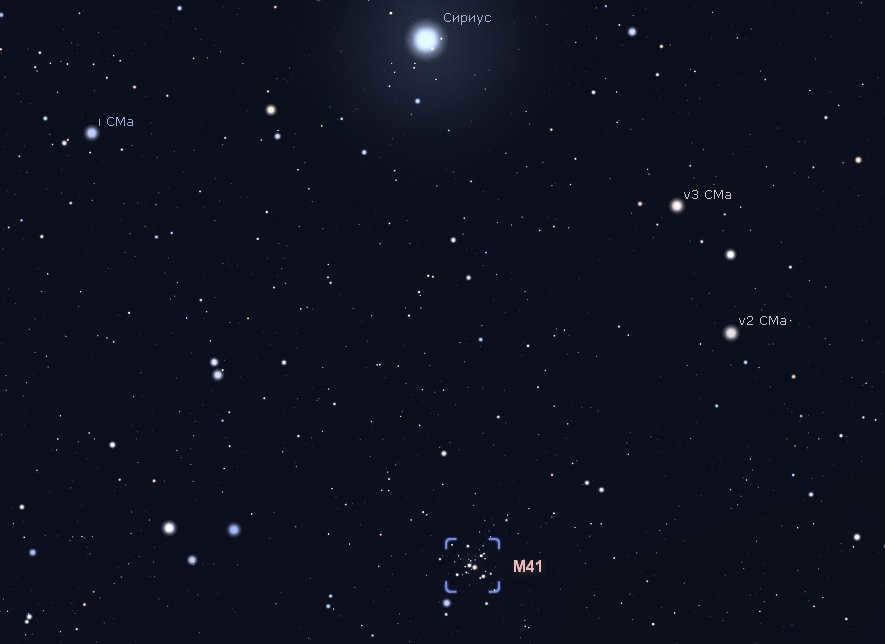
The M41 cluster can be found in close proximity to Sirius, positioned 4 degrees below and directly to the south. Its location makes it relatively easy to locate. Despite its accessibility, the cluster is not frequently observed due to its low altitude above the horizon. The best conditions for viewing this cluster occur during the middle of winter, when much of Russia experiences freezing temperatures. Nevertheless, the M41 cluster is definitely worth seeing.
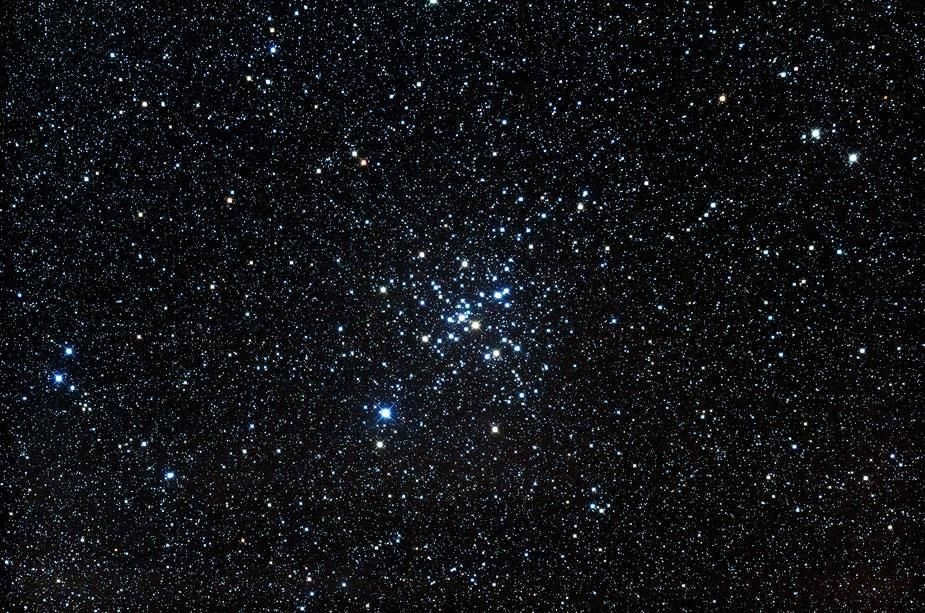
The cluster is situated approximately 2300 light years away from us, with the stars within it scattered across a span of 26 light years. The cluster dates back around 210 million years.
NGC 2362.
This particular cluster may not be as populous as M41, but it possesses its own unique beauty. It can be found in close proximity to the prominent Big Dog tau star, almost encircling it. To catch a glimpse of this cluster, simply direct your telescope towards this star. Interestingly, it is also known as the Tau Big Dog cluster, or alternatively, Godierny.
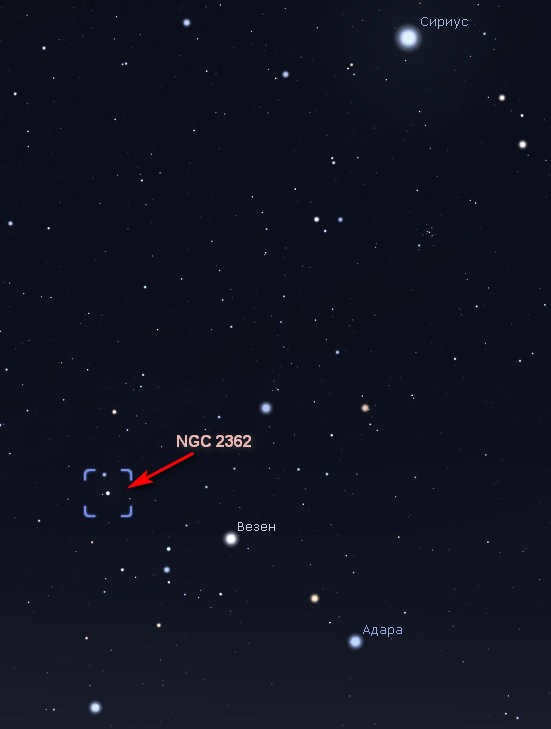
The position of cluster NGC 2362 can be observed in this image.
It is worth noting that the star Tau, which is visible in the foreground, is actually a member of this cluster and is a blue supergiant. It is estimated that the cluster is located 4,800 light-years away, and if this is true, the Tau star has a luminosity equivalent to 50,000 times that of the Sun!
The NGC 2362 cluster is believed to have an age of approximately 25 million years, indicating that it is a very young cluster.
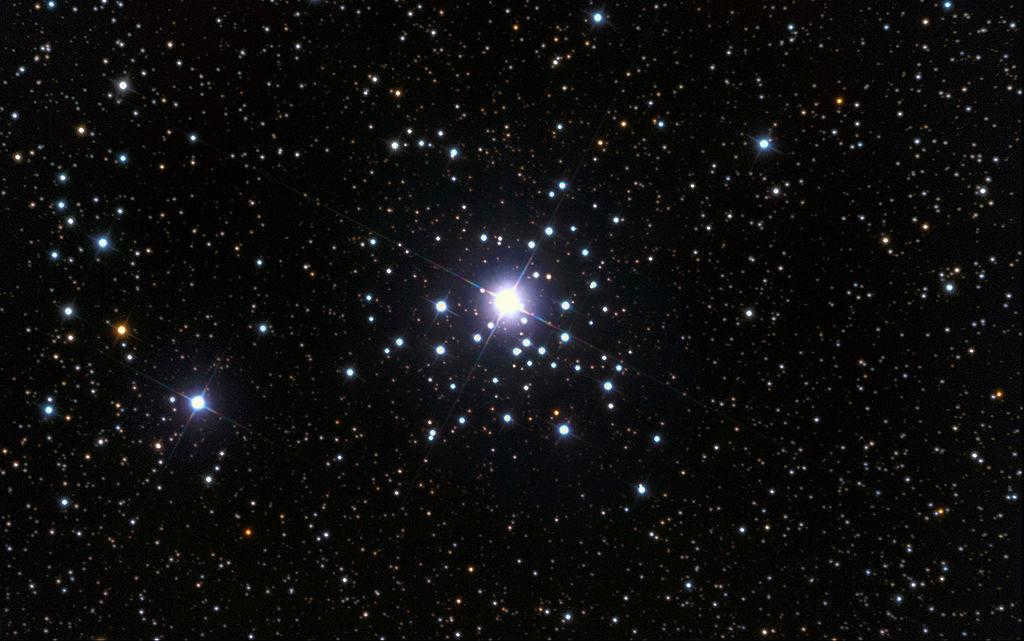
Despite its relatively small size, the Big Dog constellation contains numerous intriguing celestial objects. We have only touched upon a few of the most captivating and easily observable ones. If you possess a telescope with sufficient power, you will discover a plethora of star clusters and other fascinating entities within this constellation.
In reality, one does not need to actively seek out the Big Dog constellation – it is simply impossible to miss Sirius, the brightest star in the night sky (with a magnitude of -1.4). Situated adjacent to the Orion constellation, below and to the left, it rises later in the night.

The Big Dog constellation can be observed in the sky. While the constellation Orion can be seen in October and November, the Big Dog appears a little later. By the end of November or December, the Big Dog will be visible when Orion is high above the horizon. The Big Dog is best studied during the winter season.
Sirius, a star in the Big Dog constellation, is located in a straight line through the three stars of Orion’s belt, but slightly lower. It is easily recognizable and can help in locating the other stars in the constellation.
The Stars of the Big Dog Constellation
When it comes to the notable stars within the Big Dog constellation, there are a handful that are truly worth observing.
Sirius
This particular star within the Big Dog constellation may not possess any extraordinary qualities. However, it is one of the closest stars to us, with a distance of only 8.6 light years. This proximity to Earth is what causes it to shine so brightly, despite being only twice the size and mass of our Sun. Sirius is a hot, white star that emits 22 times more light than our Sun. If it were to suddenly swap places with the Sun, the intense heat would cause all the seas and oceans on Earth to evaporate.

The Space Engine simulator features the Sirius system.
In 1844, Bessel proposed the existence of a second component in the Sirius system. In 1862, Alvan Clarke confirmed this discovery using his new 18-inch refractor telescope. This second component was named Sirius B, or Puppy. The confirmation of Sirius B’s existence was a significant achievement for the theory of gravitation, as it started as a theoretical prediction and then became a reality.
Puppy is the first white dwarf ever discovered by humans. It has a mass roughly equal to that of the sun, but its diameter is comparable to that of the Earth. As a result, its matter is incredibly dense, with a matchbox-sized mass weighing more than a ton. Despite its mass, Puppy is not a shining star, but rather a compact object that only emits light due to compression. In other words, it is a celestial disappointment.
At one point in time, the Sirius system consisted of a pair of massive stars – one being twice the mass of the Sun (Sirius A) and the other being five times the mass of the Sun (Sirius B, also known as Puppy). However, the larger star, Puppy, rapidly exhausted its fuel and transformed into a red giant, eventually shedding its outer layers and collapsing into a white dwarf.
Even ancient records from the I-II centuries AD mention this phenomenon – for instance, Claudius Ptolemy referred to Sirius as a bright red star. Nevertheless, sources from the X century always describe Sirius as it appears today – a white star. These accounts could very well be accurate, as Puppy indeed evolved into a red giant that outshone its white companion, but now shines 10,000 times dimmer than it.
Currently, the duality of Sirius can be observed through a compact telescope, although the brightness of the primary component makes it challenging to perceive the fainter one. Nevertheless, when Puppy is displaced to its maximum separation of 11 arc seconds, it becomes relatively effortless to detect.
VY of the Enormous Canine
This star is undeniably exceptional, not only within the constellation of the Big Dog but also in the overall sky of Earth. The reason being that it is one of the largest and most luminous stars presently known – a red hypergiant, with a diameter that is 1300-1640 times greater than that of the Sun, and according to some approximations – 2100 times! In numerical terms, it equates to about 3-4 billion kilometers, or 17-19 astronomical units. Similar to numerous red giants, this star pulsates, resulting in variations in its diameter and brightness – ranging from 6.5 to 9.6m, making it visible through binoculars or a small telescope.

The whereabouts of VY Big Dog.

The stellar region surrounding VY Big Dog within the Stellarium software.
In spite of its unassuming appearance, VY Big Dog is actually an incredibly massive star. It would take light a staggering 8 hours to complete a full orbit around it (compared to just 14.5 seconds for the Sun), and a modern supersonic airplane would need to maintain a continuous speed of 4500 km/h for 220 years to circumnavigate it! If VY Big Dog were positioned in place of our Sun, its surface would extend beyond the orbit of Saturn.

A comparison between the Sun and the VY Big Dog reveals the vast difference in size.
When observing this celestial body, it is important to recognize that despite its unremarkable facade, it is a behemoth among its cosmic counterparts. Its unassuming appearance is merely a result of its immense distance from us, which spans a staggering 3,900 light years. In fact, if any ordinary star were situated at such a formidable distance, it would be virtually invisible, even when observed through the lens of a highly advanced telescope.
Star clusters within the constellation Canis Major.
The Canis Major constellation is home to a plethora of galaxies, clusters, binary stars, and an array of celestial objects. However, detecting many of these cosmic wonders necessitates a substantial telescope with an aperture of 200 mm or greater. Consequently, we will solely highlight the objects that can be observed using more modest instruments.
Cluster M41 – Canis Majoris
This cluster, known as the Heart of the Dog, is home to approximately one hundred stars and showcases a stunning display of celestial beauty. When the night sky is devoid of light pollution, this cluster can be observed with the unaided eye as a hazy spot with a magnitude of 4.6m. For those equipped with a small telescope, the intricacies of this cluster can be fully appreciated as it fills the entire field of view, even at lower magnifications.

Cluster M41’s whereabouts can be found 4 degrees below Sirius, directly to the south, making it relatively easy to locate. However, due to its low altitude above the horizon, it is not frequently observed. The optimal conditions for viewing this cluster occur in the heart of winter, when Russia experiences frigid temperatures. Nevertheless, this cluster is definitely worth a look.

The cluster known as NGC 2362 is situated approximately 2300 light years away from our location. The stars within it are spread out in a circular formation spanning 26 light years. This particular cluster has an estimated age of around 210 million years.
NGC 2362
While not as abundant in number as M41, this cluster still possesses its own unique beauty. It is positioned in close proximity to the star Tau Big Dog, almost encircling it. To observe this cluster, simply direct your telescope towards this star. Interestingly, the cluster is also referred to as Tau Big Dog, and it goes by another name – Godierny.

The position of the NGC 2362 cluster can be observed here.
Interestingly, the star Tau is not just positioned in the foreground, but it is actually a member of this particular cluster as a blue supergiant. Based on certain calculations, it is estimated that the cluster is located 4,800 light years away from our current position. If this estimation is accurate, then the Tau star possesses a luminosity of 50,000 times that of the Sun!
With an estimated age of 25 million years, the NGC 2362 cluster is considered to be relatively young.

It is evident that the Big Dog constellation, despite its relatively compact dimensions, contains numerous fascinating entities. We have only touched upon a handful of these, specifically the most captivating and easily observable ones. With the aid of a sufficiently advanced telescope, one can uncover a plethora of star clusters and other celestial objects within this constellation.

Canis Major, also known as the Big Dog, is a constellation that resembles a dog in the night sky. This constellation is often associated with the mythological story of Orion, who hunts the Hare, whose constellation is located just below Orion. Canis Major is part of a group of constellations known as the hunter group, which also includes the Lesser Dog and the Unicorn.
Description of Canis Major
The constellation Canis Major can be observed in the southern part of the sky. It occupies an area of 380 square degrees and is ranked as the 38th largest constellation out of the 88 known constellations. It is home to approximately 150 stars.
Claudius Ptolemy’s Almagest catalog refers to this constellation as the Dog and includes a total of 18 stars.
How to locate objects in the sky
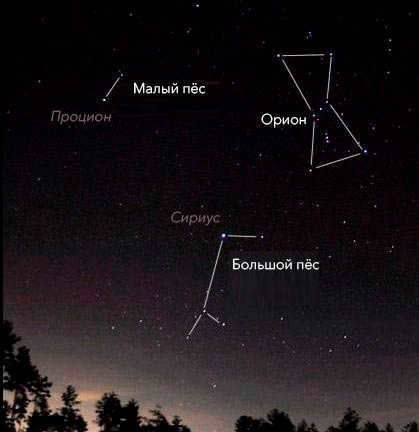
The Big Dog can be observed relatively low on the horizon. Its position in the sky will be higher the further south it is viewed. In northern latitudes, the best time to observe the constellation is from December to March, while in southern latitudes, it can be observed from November to April.
Situated southeast of Orion, the Big Dog can be found under the “foot” of the hunter. It is surrounded by neighboring constellations such as the Unicorn, Hare, Dove, and Corma. Its visibility ranges from 60 degrees north to -90 degrees south. When viewed from the southern hemisphere, the Big Dog will appear flipped over, with its head pointing downward.
Sirius, Alpha of the Canis Major.
Within the Canis Major constellation, we find the most luminous star in our celestial sphere, Sirius. Our naked eye can only observe one entity. In fact, Sirius is a binary system consisting of two celestial bodies, Sirius A and Sirius B. These two stars revolve around a shared center of mass, separated by a distance of 20 astronomical units. This measurement is 1 astronomical unit greater than the average distance between Uranus and the Sun.
The orbital period for these stars around their center of mass is approximately 50 Earth years.
Sirius A
For many years, Sirius A was believed to be the sole class A I star in existence. With a mass twice that of our sun and a radius 71% the size of our sun, it shines with a brightness 25 times greater than that of the Sun.
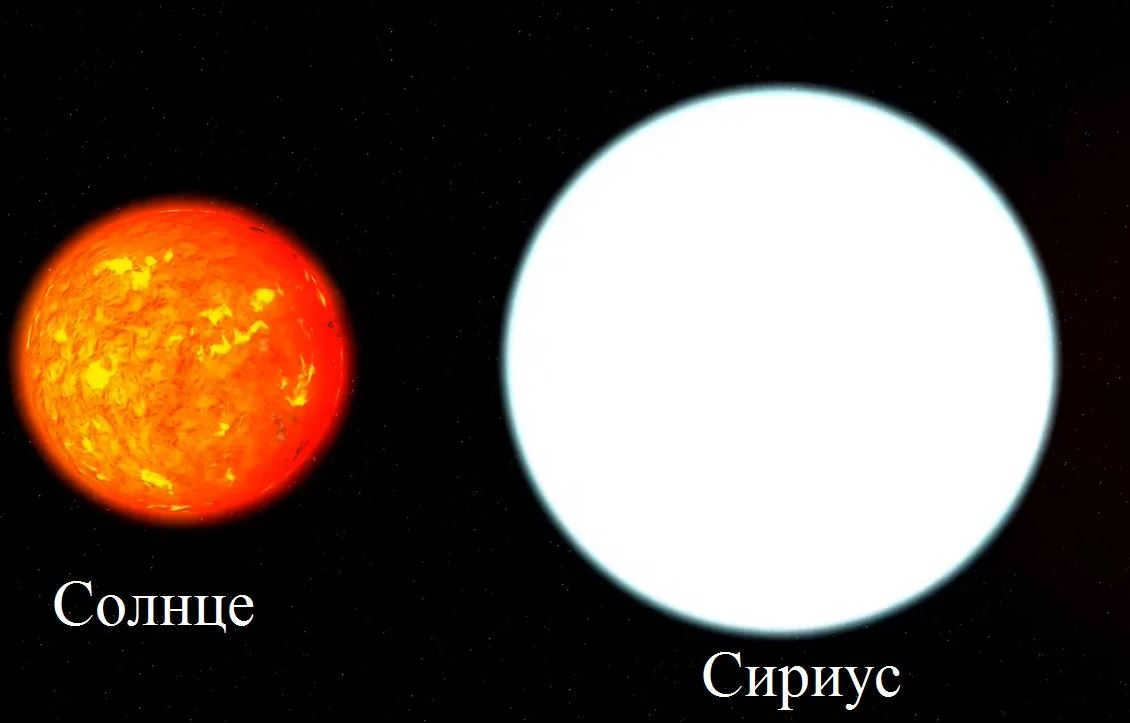
Because of its close proximity to our solar system, Sirius is a very convenient object for study: it is easily visible in the night sky and can be easily observed. The star is located just 8.6 light-years away from the center of our solar system. Sirius boasts a surface temperature of 9940K.
In comparison, the temperature of the Sun is a mere 5578K.
Furthermore, Sirius possesses a notable abundance of iron in its atmosphere. It is believed that this enrichment of metals occurred millions of years ago, possibly due to the influence of a neighboring celestial body. Sirius is expected to maintain its current state for another 660 million years before undergoing a transformation into a red giant and ultimately, a white dwarf.
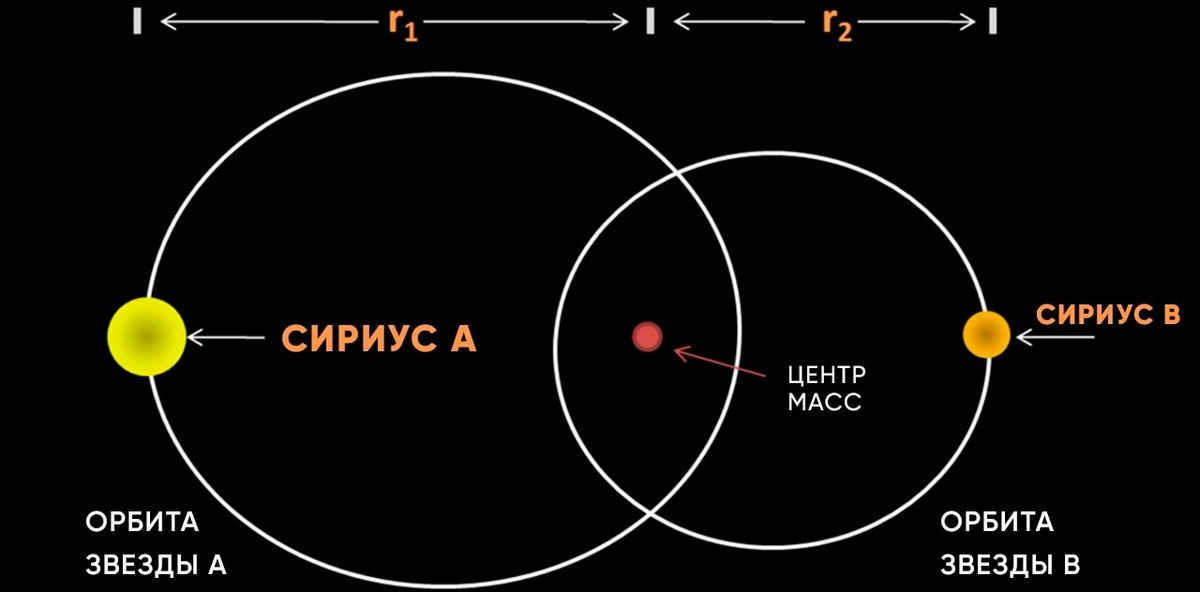
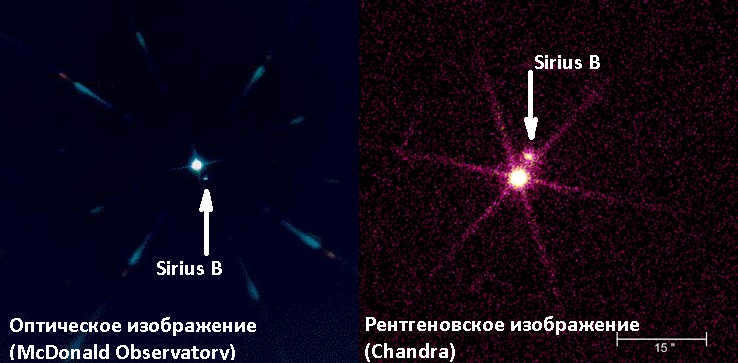
Sirius B is actually a white dwarf, and it holds the distinction of being the first white dwarf to have been observed. It was in the year 1844 that Friedrich Bessel, a renowned German astronomer, first noticed that the path of Sirius A occasionally veered away from its linear trajectory. Bessel was able to offer an explanation for this phenomenon, attributing it to the presence of an unseen mass that orbited around a common center with the star.
When this discovery was initially announced, it was met with skepticism from the scientific community. After all, for the trajectory of Sirius A to be affected in this manner, the mass of the second object would have to be equivalent to that of our very own Sun.
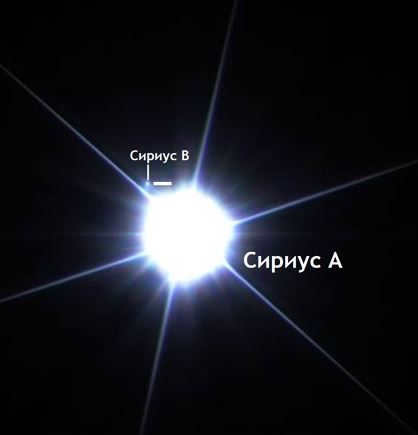
In January 1862, just 18 years after Bessel made his assumption, American astronomer Alvan Clark confirmed it. While testing a new telescope, Clark discovered a small star near Sirius that matched Bessel’s calculations and hypotheses.
This star was named Sirius B and is the heaviest known white dwarf to astronomers. It has a mass equal to that of the Sun, but its volume is 1 million times smaller and its diameter is nearly the same as Earth’s.
Presumably, the conversion of the celestial body from a red giant to a white dwarf happened approximately 120 million years ago, when its mass reached the equivalent of 5 times that of the Sun. Sirius B is practically imperceptible to the naked eye, as its luminosity is a mere 0.026 of the Sun’s radiance. Additionally, it boasts a surface temperature of 25,200 K.
Additional stars within the Canis Major constellation
The constellation Canis Major is home to a multitude of stars that can be observed without the aid of a telescope.
Adara, Epsilon
Adara, also known as Adhara, is a member of the blue giant class and is the second brightest star in the constellation. Despite being located 400 light-years away from our solar system, it can still be observed in the night sky without the aid of telescopes or binoculars. Adara ranks as the 22nd brightest star among all known stars.
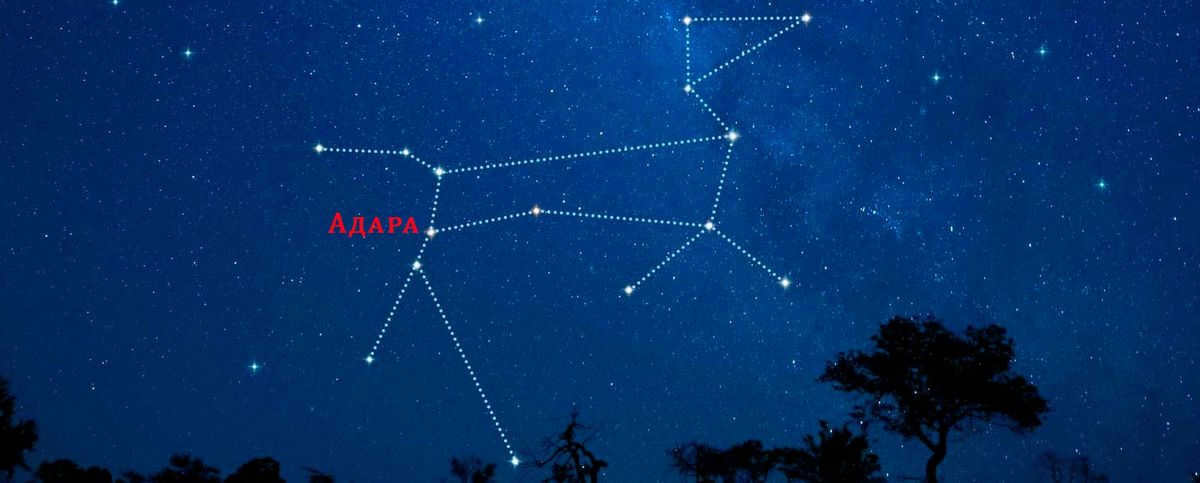
Adara is a binary star system. Adara A is classified as a B2 II star and is approximately 20,000 times brighter than the Sun. It has an apparent magnitude of 1.5m and a surface temperature of 22,600°C. Adara A has a radius about 8 times that of the Sun and is estimated to be around 22.5 million years old.
About 5 million years ago, Adara was located 34 light-years away from Earth and was the most luminous star in the sky.
The main star, Adara A, has a companion called Adara B. Adara B is located approximately 900 astronomical units away from Adara A and completes a full orbit around it every 7,500 years. The apparent magnitude of Adara B is 7.5m.
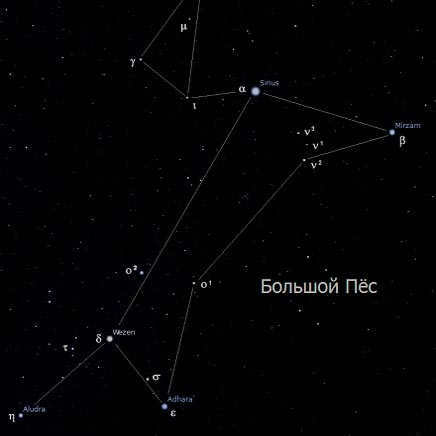
Translated from Arabic as “tether,” other names for the star are Mirzam, Murtzam, and Murtiam. It can be observed in the celestial sphere to the right of Sirius, positioned on the forepaw of the constellation Canis Major. The star is classified as a blue-white giant with a spectral class of B1 II-III and has an apparent magnitude of approximately 2. Sirians shine about 19,000 times brighter than our Sun. The star is located at a distance of approximately 500 light-years. Its surface temperature is estimated to be around 22,000K. The star rotates with a speed of 36km/s.
Aludra, Eta
Aludra and Eta are two stars in the constellation Canis Major.
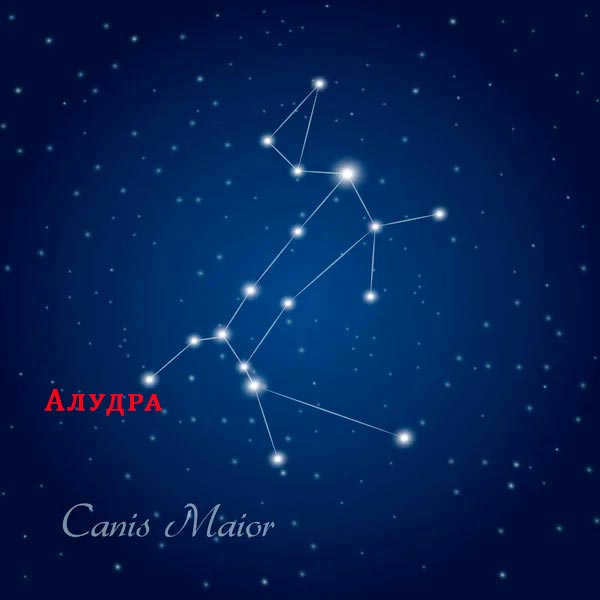
Alternative spellings include Aludra and Al-Udra. This particular star is classified as a B5Ia and is a stationary blue supergiant. It has an apparent magnitude of 2.45 m. It is estimated to have a radius 30 times larger than the radius of the sun and is located at a distance of approximately 300 sv years. The star’s luminosity fluctuates every 4.7 days. All of the data provided are approximations due to the significant distance to the object.
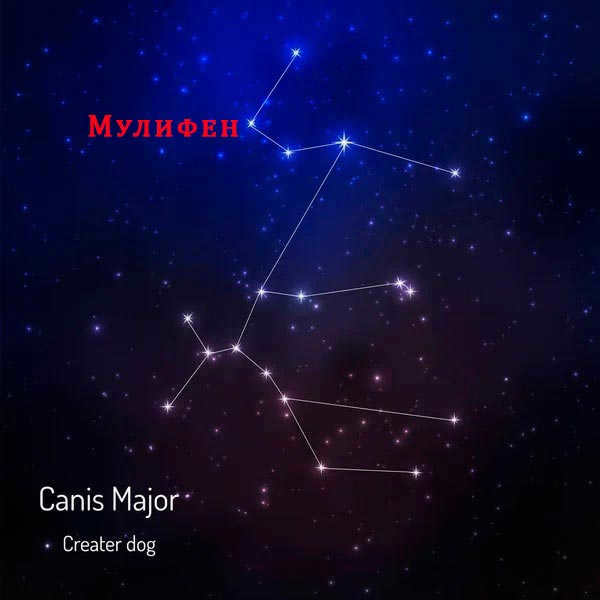 Muliphene or Gamma
Muliphene or Gamma
Muliphene, also known as Gamma, is a star classified as B8II. It is a blue-white giant with a mass of 4.3 times that of our Sun. The star has a radius that is 5 times larger than the radius of our Sun. Its visible magnitude is approximately 4.15m.
This star has a surface temperature of 13600 K and is located at a distance of 400 light years from Earth. Its rotation speed is relatively slow, measuring only 30 km/s.
What makes Muliphene unique is its classification as a mercury-manganese star. It contains 40% more iron and chromium compared to the center of our solar system. In fact, it is 2,000 times richer in mercury than our Sun.

Vezen, Delta constellation
This celestial body is a member of the F8 Ia class of white-yellow giants and is situated 1,800 light-years away from our solar system. It boasts an apparent magnitude of 1.85. Vezen has a mass that is 17 times greater than that of our Sun and its surface temperature measures 6,000K. Scientists estimate that this star has been in existence for approximately 10 million years. As time progresses, it is expected to evolve into a red giant before eventually undergoing a supernova explosion.
Tau
Tau is an incredibly massive star that has captivated the attention of scientists worldwide. With a diameter of 2.5 million kilometers, it stands as one of the largest stars ever discovered. What truly sets Tau apart is its astonishing brightness, which is a staggering 270,000 times more intense than the Sun. Despite its immense size and luminosity, Tau is relatively close to Earth, with a distance of only 3,200 centimeters. Classified as a O9Ib star, Tau shines with a visible stellar magnitude of 4.37 m. The scorching surface temperature of this celestial body reaches a searing 33,000 degrees Celsius.
Additional items in the constellation
Canis Major contains over 40 distinct celestial objects within its boundaries. Numerous of these entities hold particular fascination for those with an interest in astronomy.
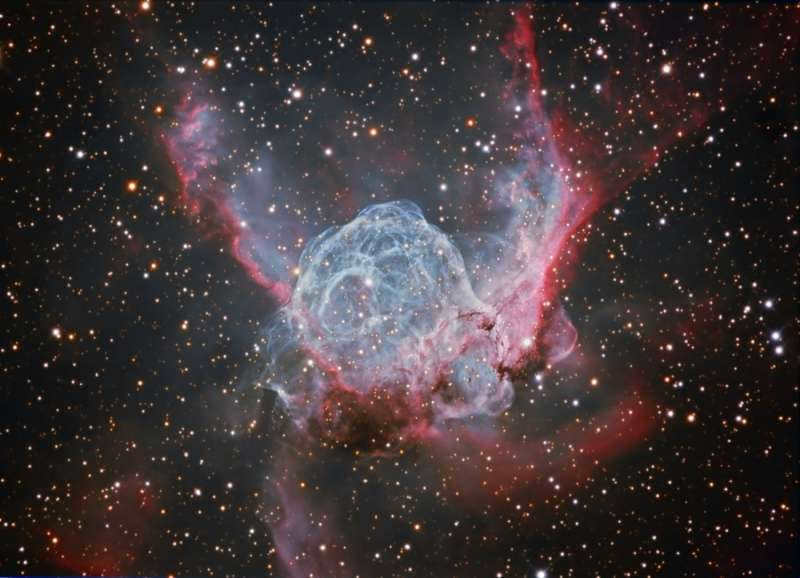
- The NGC 2359 or LBN 1041 Nebula, also known as Thor’s Helmet Nebula, can be found above the head of the Dog constellation. This emission nebula is located approximately 12-15 thousand light years away from us. It has a unique appearance resembling a Scandinavian helmet with wings. Due to its distance, it can only be observed through a telescope. The nebula was first discovered by William Herschel in 1785. At the center of the nebula, there is a hot blue giant star that is nearing the end of its life and is expected to explode as a supernova.
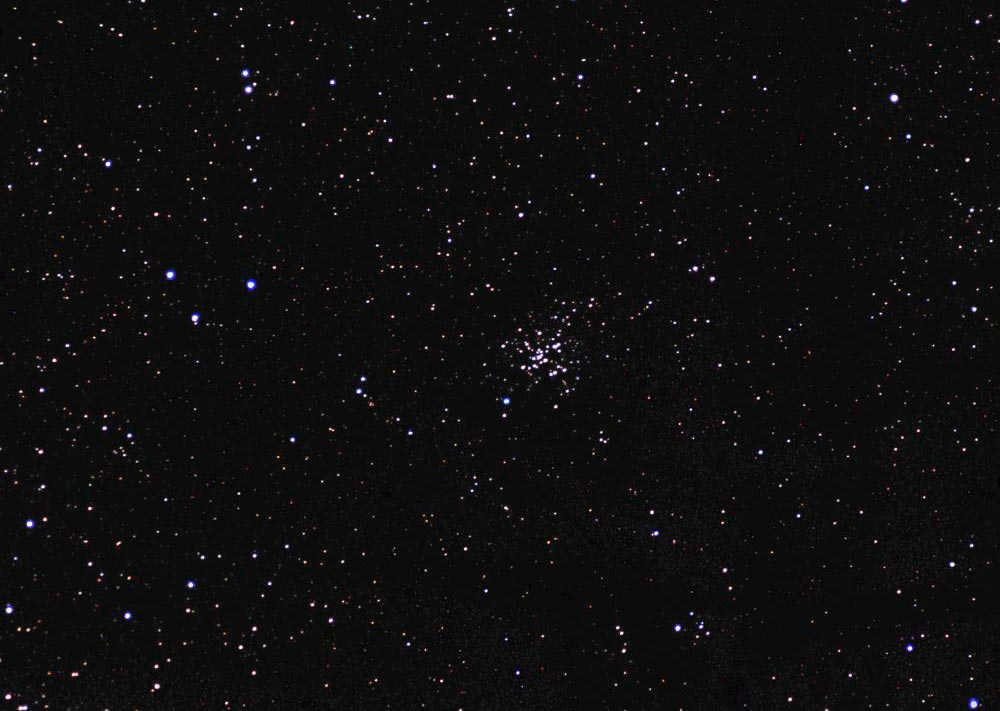
- Giovanni Godierna discovered M41, also known as the Little Beehive cluster, in 1654. This dazzling cluster is home to over 100 stars and can be easily spotted in the night sky, particularly near the Dog constellation.
Discovered in 2003, this celestial object was surprisingly found to be closer to Earth than the center of our galaxy. Its precise location was obscured by dense clouds of gas and dust, which are much more concentrated outside the boundaries of the Milky Way. Despite its small size, this dwarf galaxy is estimated to be located approximately 25,000 light-years away from our solar system and 42,000 light-years away from the center of the Milky Way galaxy.
According to scientists, this dwarf galaxy is predominantly composed of red giants and is home to approximately one billion stars.
Fascinating information about Sirius
The prominent star has been visible in the sky for centuries and continues to be a subject of study.
By examining celestial bodies in the Canis Major constellation, researchers and hobbyist astronomers gain knowledge about nearby stars like Sirius as well as far-off galaxies and nebulae.
Q&A
What is the distance between Earth and the star Proxima Centauri?
The star Proxima Centauri is located a mere 4.2 light-years away from Earth.
Are the constellation Hound Dog and the Big Dog the same thing?
No, the constellation Hound Dog and the Big Dog are two different objects in the sky. The Hound Dog is located northwest of the Big Dog.
Are the stars in a constellation all at the same distance from Earth?
No, the stars that make up a constellation can be located at different distances from Earth. For example, Sirius is only 8.6 light-years away, while Muliphene is 400 light-years distant.
What are giants in astronomy?
In astronomy, giants are stars that have a high luminosity of 10 to 1000 and a radius of 10 to 100 times that of the Sun. This term was coined by the Danish astronomer E. Herzsprung in 1906.
How long is a light year in kilometers?
A light year is equal to 9,460,730,472,580.8 kilometers.
Exploring Fascinating Celestial Objects in the Constellation: A Video Review
As you are aware, the Big Dog constellation is situated in the Southern Hemisphere. Its notable characteristic is that it encompasses the most brilliant star within it, Sirius.
In terms of its placement, it is surrounded by neighboring constellations such as Unicorn, Dove, Hare, and Corma. As for its size, it is considered to be of average magnitude. More specifically, it covers an area of 380 square degrees, ranking it in the 43rd position.
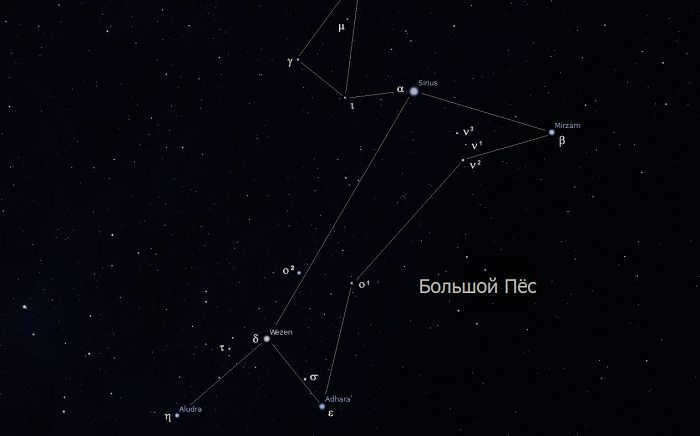
The main stars in the constellation of the Great Canine.
Without a doubt, in terms of their appearance, the celestial bodies in this constellation bear a striking resemblance to a dog.
The most prominent star, undoubtedly, is Alpha. — Sirius.. It is widely recognized as the most brilliant star in the skies.
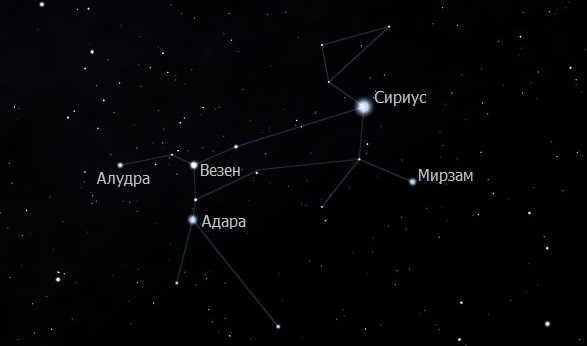
There is no question that the Big Dog constellation is composed of more than just Sirius. Following it, the most luminous stars in the Dog constellation are:
Epsilon – Adara, the second most luminous star in the region. It is actually made up of two components. One is the brightest source of ultraviolet radiation and belongs to the B2 spectral class. At one point, Adara was the most luminous celestial body with an absolute magnitude of -3.99. According to scientists, no object will surpass its previous luminosity within the next 5 million years.
Delta – Wesen is a yellow-white supergiant. It ranks third in brightness within the constellation.
Beta — Mirceam is represented by a prominent member of the Beta-Cepheids variable class. It is worth noting that it rises slightly earlier than Sirius and is a giant of a white-blue hue.
This — Aludra is a supergiant of a blue color. At the same time, it is a variable star of the Deneb type. Astronomers predict that it will soon undergo a supernova event.
Tau The Big Dog is classified as an eclipsing spectroscopic double star system. Additionally, Tau is a variable blue giant similar to Beta Lyra.
Zeta — Furud is a binary system, and Theta is an orange giant.
Kappa and Iota are blue supergiants. In contrast, Gamma — Muliphene is a blue-white giant.

Notable celestial objects in the Canis Major constellation
It should be mentioned that within the boundaries of the Canis Major constellation, there exist several intriguing astronomical objects. Furthermore, 4 stars within this constellation have their own planetary systems.
Indeed, one of the most stunning features is the Messier 41 open cluster, which boasts approximately 100 stars. Additionally, there is the youthful cluster NGC 2362. It is interesting to note that many of its components orbit around the star Tau.
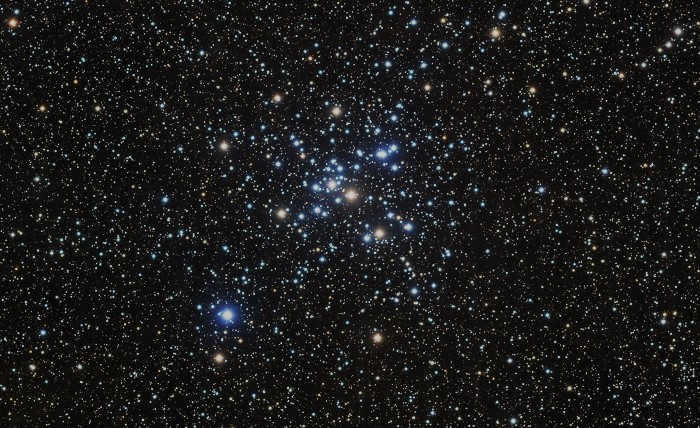
Furthermore, amidst the celestial bodies within the Canis Major constellation lies the hypergiant star known as VY of the Great Canine. Incidentally, this particular star is among the most massive and luminous in existence. Just imagine, its diameter measures approximately 2.5 to 2.9 billion kilometers. Currently, scientists are devoting their efforts to studying and analyzing this extraordinary cosmic entity. There still remains some debate among researchers regarding certain properties of this star, such as its precise size. Some assert that the diameter of VY of the Great Canine is merely 600 times that of the Sun, while others argue that it has already reached a size 2,000 times greater.
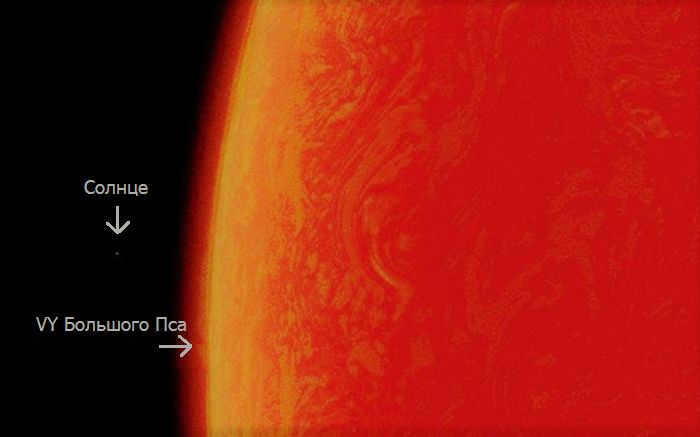
It is conceivable that in the future, researchers will establish the precise magnitude of the entity. However, at present, it is evidently a matter of considerable uncertainty.
In addition to all of the aforementioned components, the constellation of Canis Major incorporates a diminutive galaxy. Remarkably, it is referred to as an irregular elliptical galaxy. However, of significance is the fact that it is one of the nearest to our own. Furthermore, it encompasses a billion stars. Intriguingly, it was only detected as recently as 2003.
Unluckily, the Dwarf Galaxy of Canis Major is virtually unobservable. Since it is concealed by the Milky Way region. Nevertheless, astronomers have scrutinized this concealed region. They have discovered a substantial number of red giants within it.
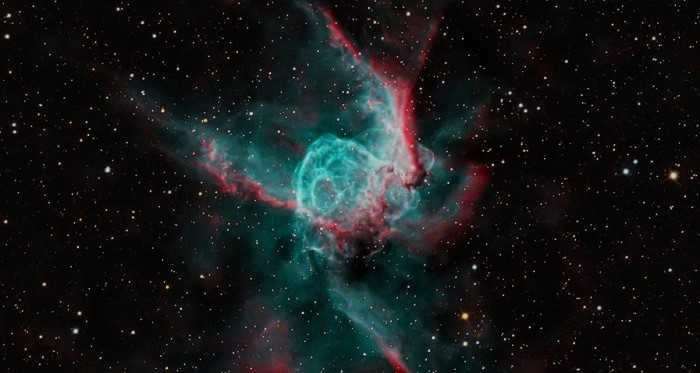

Additionally, situated in this vicinity is the NGC 2359 emission nebula, commonly referred to as Thor’s Helmet.
Furthermore, in this constellation, you can find spiral galaxies such as NGC 2207 and IC 2163. Interestingly, these two celestial objects are separated by a staggering 80 million light-years. Nevertheless, it has been determined that they are in the process of merging with one another.
Myth
The story behind the constellation Big Dog is often associated with the myth of Orion’s celestial canine companion. However, there are instances where the dog is depicted as a loyal friend of Icarius.
There is also a legend about the swiftest dog – Lelapa. According to the myth, Zeus gifted a dog and an infallible spear to Europa, the daughter of the Phoenician king. Unfortunately, Europa’s husband, Cephalus, accidentally killed her while hunting. As a tribute, Zeus immortalized the dog in the heavens.
Every wise person knows that reaching for the stars is an impossible feat, but the intelligent ones, disregarding the naysayers, still strive to achieve it.
Harry Anderson
Experienced astronomers suggest that the best time to observe the constellation in the sky is from December to January. In Russia, it can be seen in its entirety from the central and southern regions, although only partially visible in the northern part. Furthermore, a telescope can be used to study the constellation in more detail.
Regrettably, there is a limited window of visibility for this area, as the Big Dog constellation rarely rises above the horizon.
The Dog constellation is situated on the southeastern side of Orion, and it is worth noting that it partially intersects with the Milky Way.
Aside from its unique shape, the presence of the brightest star also contributes to the popularity of the Big Dog constellation.
Identifying the winter constellation known as the “Big Dog” is not a challenging task when observing from Russia. This peculiar collection of stars can be easily seen in the central and southern parts of the country. However, in the northern regions, the cluster may not be fully visible, making observations more difficult. Of particular interest within this constellation is the blue-white star known as Sirius, which shines brightly in the southern sky. For optimal study, it is recommended to observe the “Big Dog” during the early and mid-winter months.
Location and Appearance of the Canis Major Constellation in the Sky
Situated in the southern hemisphere, the Canis Major constellation occupies its position. It is adjacent to the constellation “Orion” in the north, and “Unicorn” in the south. “Feed” and “Dove” can be found to the south. This group of stars emits a brightness that is twenty times greater than that of our sun and is spread over an area of 380 square degrees. Its distance from Earth is approximately 2.60611184733 parsecs.
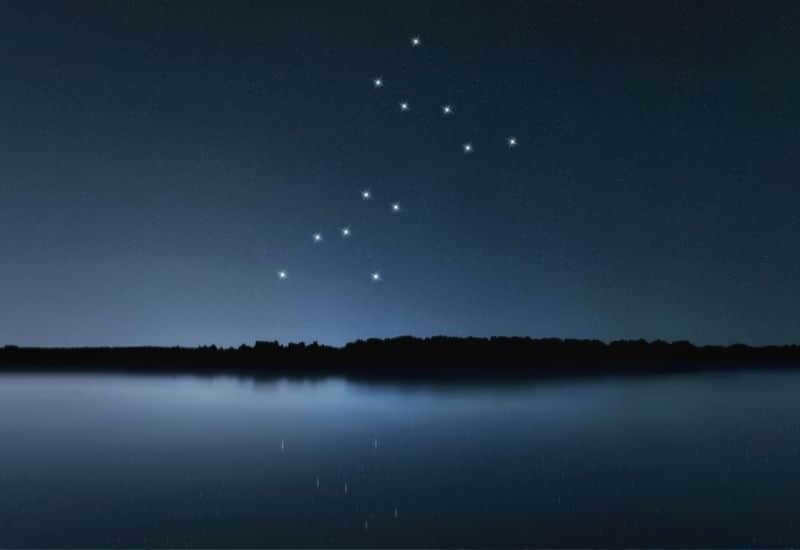
The reason for the limited viewing opportunities is the position of the Big Dog. “The Big Dog does not rise very high above the horizon at any time during the day. This constellation occupies a portion of the Milky Way and is known for its distinct pattern and compactness. The brightest star in the Big Dog constellation is Sirius A. The cluster also includes several other stars with different masses, parallaxes, declinations, and distances from Earth, such as Adar and Sirius B.”
General Information
Overview:
- Abbreviated name Constellation Canis Major.
- Visible at latitudes ranging from +57° to -90°.
- Declination ranges from -33° to -11°.
- Direct ascent occurs from 6:07 am to 7:22 am.
- Ranks 43rd in terms of occupied area.
- The brightest stars in this constellation are Sirius, Adara, Vezen, Mirzam, and Aludra.
No meteor streams are associated with this constellation.
Take a good look at the Big Dog constellation, which can be best seen below the fifty-seven-degree latitude in the southern hemisphere. Any amateur stargazer will instantly recognize the unique arrangement of stars in the night sky. The cluster of stars is situated to the southeast of Orion, and you should search for the “dog” just below Orion’s right foot. The neighboring constellations include Hare and Unicorn as well.
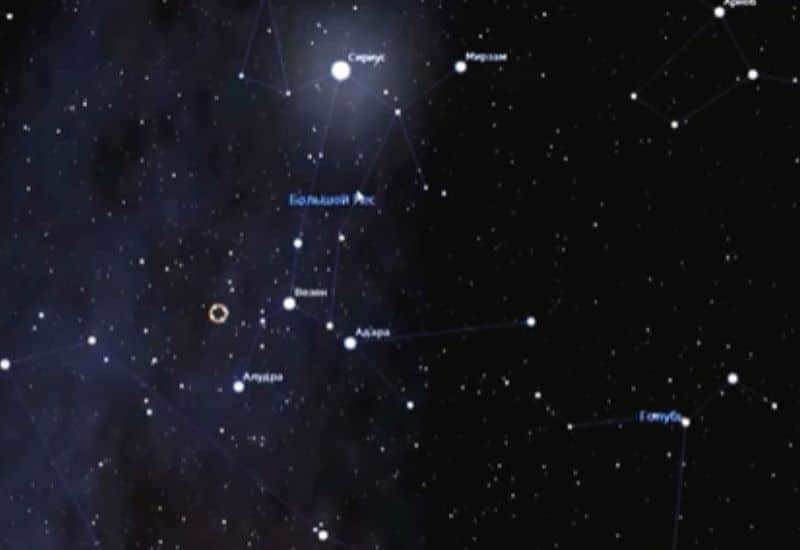
How to Identify the Constellation of the Big Dog in the Night Sky
For those new to astronomy, it’s quite simple to recognize the Big Dog constellation by its distinct pattern. By scanning the Milky Way in the night sky, you can easily spot Sirius, the lesser-known main-sequence star. It forms a connection between the dog’s chest and neck. Another way to locate the Big Dog constellation is by looking for Adara, a bright blue-white giant situated in the animal’s paws.
When can you see the Big Dog constellation, where should you look, and what else can you observe?
If you are located further north, you will only be able to partially distinguish the unique pattern of stars. During the autumn months, you can easily spot the constellation in the morning hours. It fully rises by 6 a.m. On the southern side, you can see the “Big Dog” almost every night during mid-winter. As the spring months approach, the constellation becomes visible in the southwest after sunset.
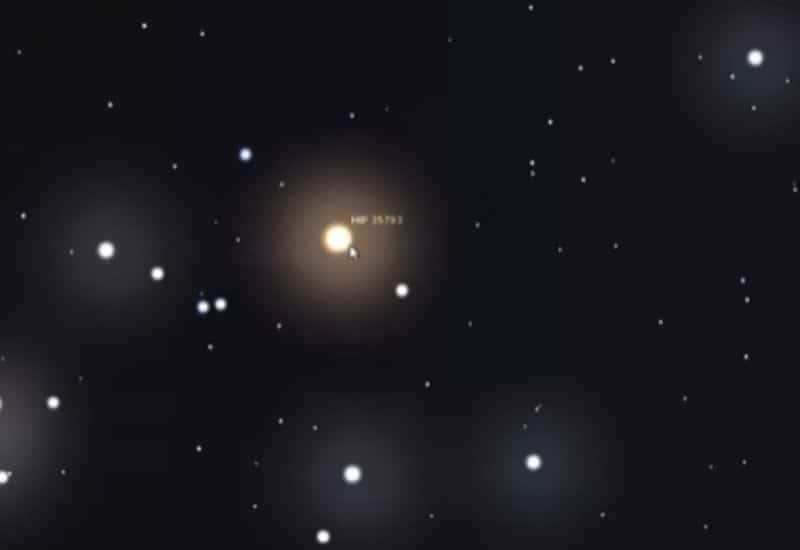
In the month of April, the Big Dog constellation becomes visible for approximately sixty minutes after our star sets. Observing the cluster during the evening hours of May can be challenging. However, locating the celestial formation known as the “Big Dog” is quite simple. The prominent star on the main sequence acts as a reliable guide and can be spotted from almost anywhere in the country. The only exception is the northern regions, particularly the settlement of Dickson.
The constellation known as the Big Dog contains approximately 148 celestial bodies that are easily visible to the naked eye. Among these, the most prominent is Sirius, which is not only the brightest star in the constellation but also a supergiant, blue-white giant, and variable star. Canis Major, the official name of the Big Dog constellation, is frequently mentioned in Greek mythology. In ancient Sumerian-Akkadian texts, it was referred to as the Arrow and was associated with Nibib, the god of rain, floods, and war.
Ancient Egypt attached great significance to a particular star. The radiance of Sirius served as a harbinger to the priests, indicating an inevitable occurrence. The ancient Egyptian texts proclaim, “Sotis great shines in the sky, and Hapi emerges from its banks.” In ancient Rome, the star’s morning visibility coincided with the summer heat and was synonymous with “dog days,” signifying a period of rest and leisure. By clicking the link, you can discover a plethora of intriguing details concerning this enigmatic binary luminary.
The enigmatic celestial body Sirius or α Canis Majoris (Alpha Canis Majoris).
It is part of the principal series and is categorized as a binary:
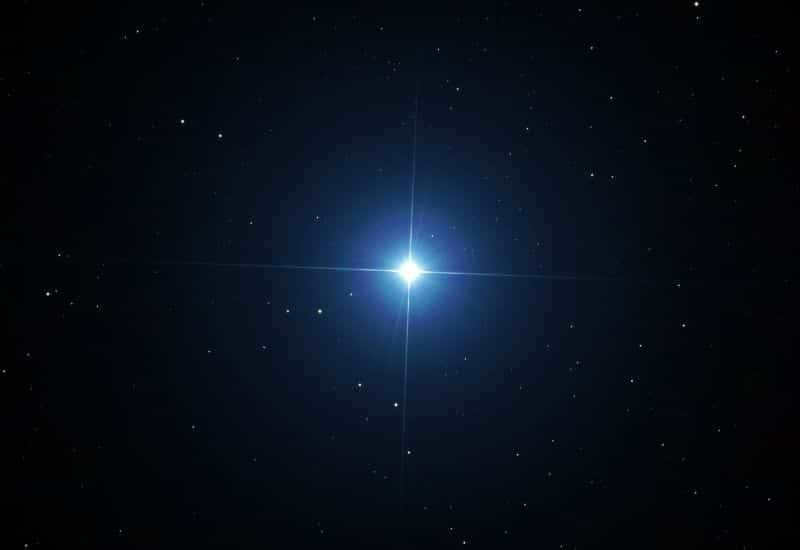
- A1 is the spectral class.
- It has a luminosity 25 times higher than the solar luminosity as a result of its proximity to the Earth-group planets.
- The distance to the Earth-group planets is approximately 8.60 ± 0.04 light-years.
- The temperature of Sirius is estimated to be 9940 K.
In 1862, Alvan Clarke, an American astronomer and manufacturer of professional optics, confirmed the theory proposed by his European colleague F. Bessel regarding the existence of Sirius A, a companion known as Sirius B.
Adara: The Prominent Binary Star in Canis Major
Adara, also known as Epsilon Canis Majoris (Epsilon of the Great Dog), is the second brightest star in the constellation after Sirius.
- It belongs to the spectral class A1.
- Its luminosity is twenty thousand times that of the Sun.
- The distance to Earth is approximately 131,839 parsecs.
- The temperature of Adara is 24,750 K.
About 4.8 million years ago, during the early days of Homo Sapiens, Adara shone as the brightest star in the Earth’s sky, and the distance to the Canis Major constellation was approximately 34 light years.
The third star Wesen or δ Canis Majoris (Delta of the Big Dog)
Wesen is the name given to the third star in the constellation Canis Major, also known as δ Canis Majoris. It is a yellow-white hypergiant and is considered to be the third most luminous celestial body in this constellation.

- The F8 la spectral class defines this celestial body.
- It is approximately 1 . 10 7 years old.
- The distance between the Earth and the group of planets it belongs to is 490 pc.
- Its temperature measures 6200 K.
At the beginning of the left hip, there is a peculiar cluster where the star can be easily detected.
The significant star Myrtsam or β Canis Majoris (Beta of the Big Dog)
There are various theories regarding the etymology of the name, which is a combination of “herald” and “tether”. This blue-white giant is a pulsating variable that belongs to a region of sparse, hot gas along with the solar system.
- Spectral class B1 (not permanent).
- Distance from the Sun is 66.7 pc.
- The temperature is 25,320 K.
- The rotation is 36 km/s.
The end of the foreleg is where the luminosity is situated within the cluster. The positioning of the luminosity is also recorded in the Almagest.
Blue star Aludra or η Canis Majoris (Eta Big Dog)
Aludra shares many similarities with another blue supergiant in the constellation of Cygnus – Deneb. Both stars are included in the list of the brightest and are located approximately 3000 light years away from Earth. Along with Delta Canis Majoris, Aludra is part of a group of stars that are either gravitationally unbound or weakly bound.
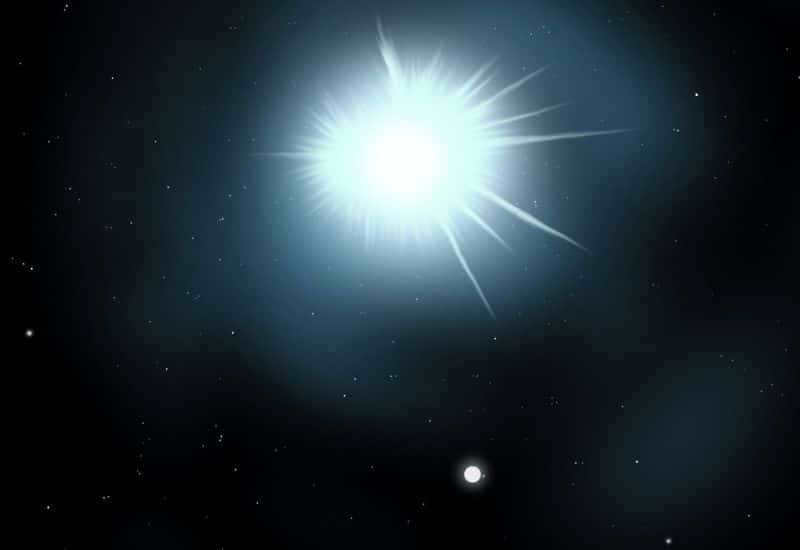
- With a radius 30 times larger than that of the Sun.
- Having a temperature of 18,000 K.
- Belonging to the spectral class B5 la.
- Exhibiting a luminosity that is 100,000 times greater than that of the Sun.
Aludra, situated on the opposite side of Sirius, is part of the traditional constellation pattern in the sky, along with other stars in the Big Dog constellation.
The most notable celestial objects in the Big Dog constellation
In addition to the aforementioned group of stars with various spectral classes, the constellation Hound Dog can also be observed in the sky. This is a distinct small cluster located in the northern part of the sky. It consists of 57 visible stars without the need for telescopes or binoculars. The best time to observe this small cluster in the sky is from March to April, particularly from the territory of Russia. One distinguishing feature of the Hound Dogs is the absence of bright stars.
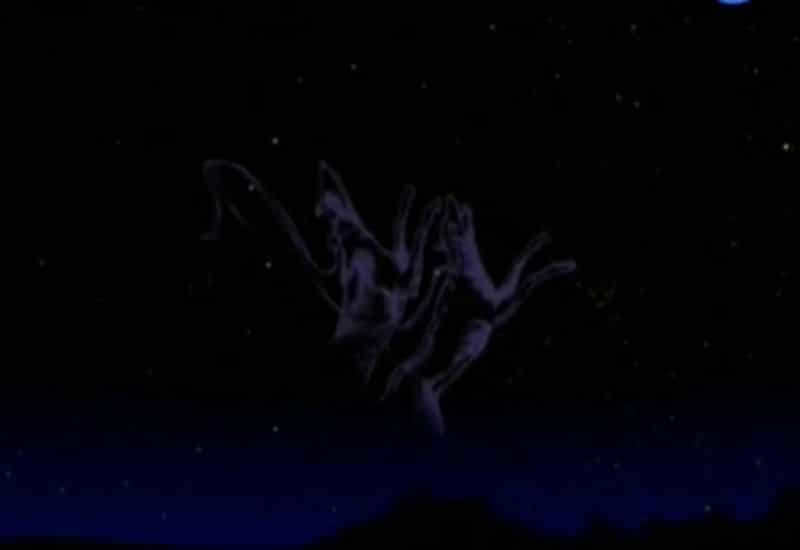
The Hound Dog constellation stands out due to its collection of remote galaxies, nebulae, star clusters, binary stars, and other fascinating celestial entities. To fully observe the gas formations in the depths of space, it is necessary to utilize specialized optics with an aperture of 200 mm or greater. Attempting to study these distant objects with the naked eye would prove challenging.
The unusual Messier 41 cluster (M41, NGC 2287).
Among the collection of well-known and stunning dispersed clusters that have been observed in the constellation, there is the peculiar Messier 41 cluster. This cluster is located at a distance of 705.1832 parsecs from the Earth’s group of planets. The cluster consists of over 100 different luminaries and can be found four degrees south of Sirius, covering an area equivalent to 25-26 sv. years. NGC 2287, appearing as a hazy spot, is easily visible to the naked eye, but with the aid of a telescope, one can examine the celestial bodies in greater detail. The age of the M41 cluster is estimated to be between 190-240 million years.
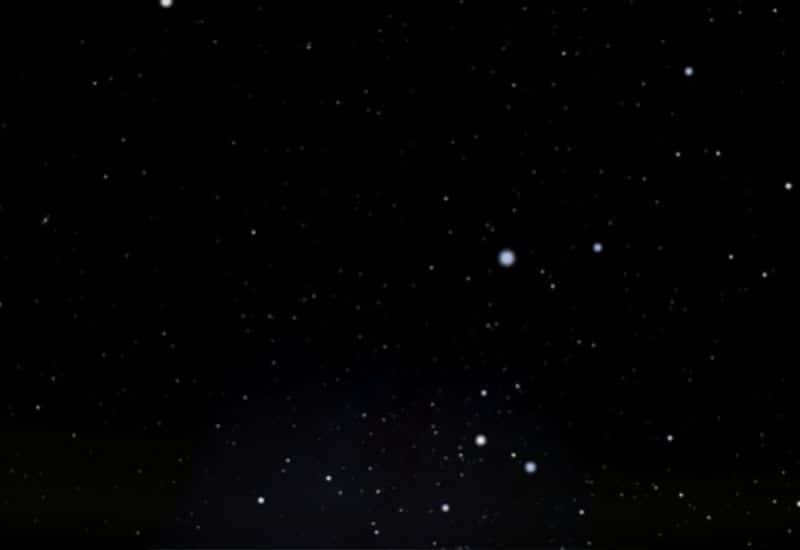
A peculiar small galaxy in Canis Major.
This unusual, theoretical galaxy is a member of the Local Group and is distinguished by an abundance of red giants. The cluster is home to more than 1 quintillion stars.
Additional characteristics:

- Characterized by an irregular elliptical shape;
- Relatively close proximity to the solar system (7665.0348 parsecs);
- Observed and documented by astronomers worldwide in 2003;
- It is believed that the gravitational field of the nearby galaxy accumulates the necessary conditions for its disruption.
The observation of the star cluster is made difficult by the presence of cosmic gases and galactic dust.
The enigmatic nebula NGC 2359, also known as “Thor’s Helmet”
Scientist W. Herschel discovered this intriguing emission nebula on January 31, 1785. Its unique shape is the result of stellar wind and a massive star located in the central part of LBN 1041. The blue hot giant has a relatively short lifespan and is expected to eventually undergo a supernova event. “Thor’s Helmet” is situated at a distance of 4599.0209 parsecs from Earth.
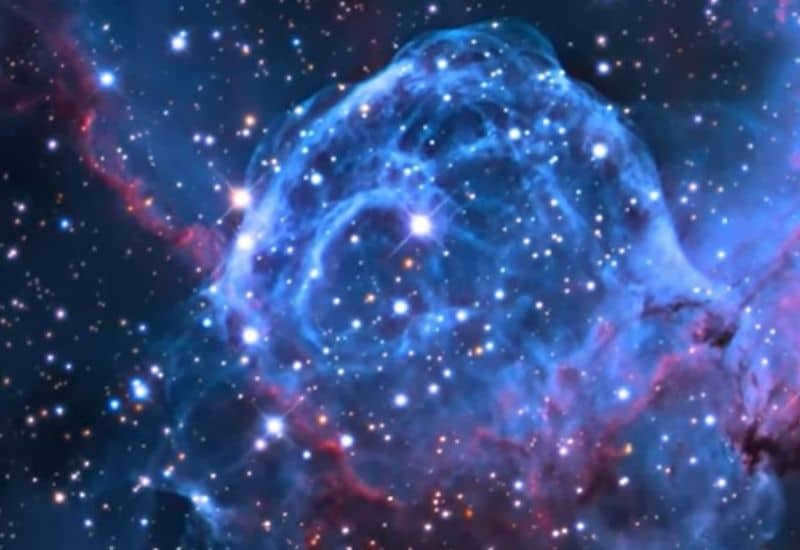
Astonishing Sight: The Union of Two Galaxies, NGC 2207 and IC 2163
Space is filled with countless breathtaking wonders, and among them is the mesmerizing phenomenon of two galaxies merging. NGC 2207 and IC 2163 have intertwined into a single spiral, where the larger entity engulfs and absorbs stellar matter from its smaller counterpart. Additional characteristics include:
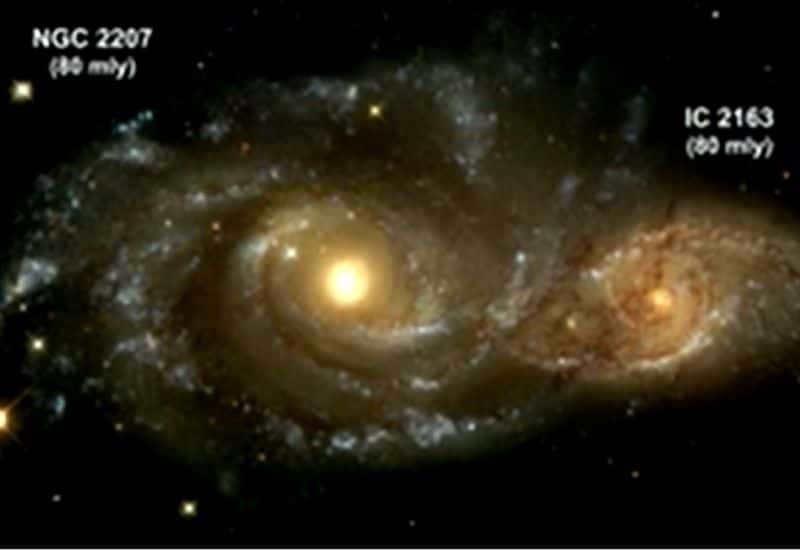
- The planets in the Earth-group are located at a distance of 24528111.504 parsecs from Earth;
- NGC 2207 has recorded the occurrence of 3 supernovae;
- The stellar magnitudes are 12, 2/11, and 6.
An English accountant named D. Herschel was successful in discovering galaxies in 1835.
Ancient Greek mythology is closely linked to this constellation.
Many of the extraordinary cosmic formations have been recognized by people since ancient times. The Canis Major constellation is no exception. It is well-known that the Orion cluster is located nearby. The name of this constellation was given to honor a renowned hunter from ancient Greek myths. Canis Major and Canis Minor – faithful companions – are positioned next to each other, with Canis Major on the right side.
Another ancient Greek legend revolves around the pursuit of Lilap, a swift dog. During a specific moment, he chased after an equally fast fox. The chase lasted for a considerable period, and Zeus, tired of the prolonged pursuit, transformed Lilap into a prominent constellation and the fox into stone.

